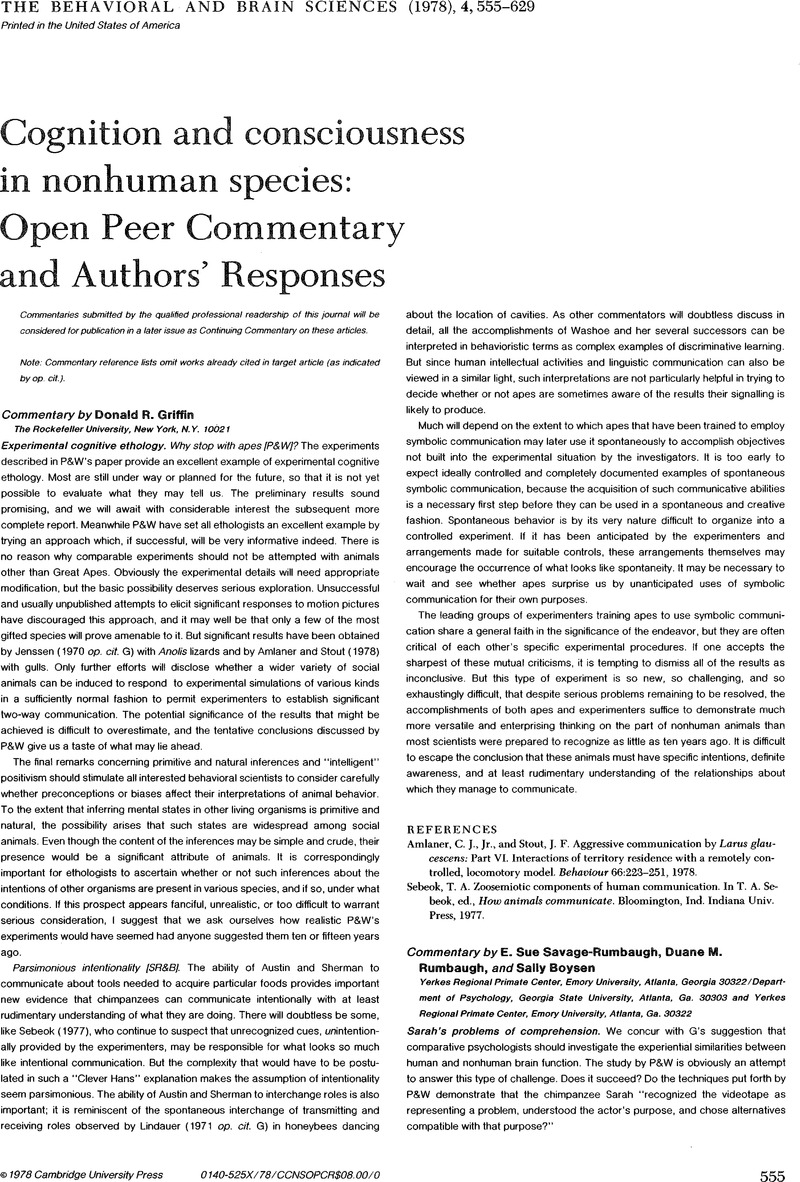Crossref Citations
This article has been cited by the following publications. This list is generated based on data provided by Crossref.
Ristau, Carolyn A.
and
Robbins, Donald
1982.
Vol. 12,
Issue. ,
p.
141.
Ristau, C. A.
and
Robbins, D.
1982.
Animal Mind — Human Mind.
p.
299.
Maxim, Peter E.
1982.
Contexts and messages in macaque social communication.
American Journal of Primatology,
Vol. 2,
Issue. 1,
p.
63.
HARRIS, PAUL L.
1992.
From Simulation to Folk Psychology: The Case for Development.
Mind & Language,
Vol. 7,
Issue. 1-2,
p.
120.
Bechtel, William
1993.
Decomposing intentionality: Perspectives on intentionality drawn from language research with two species of chimpanzees.
Biology & Philosophy,
Vol. 8,
Issue. 1,
p.
1.
Phillips, Wendy
Gómez, Juan Carlos
Baron‐Cohen, Simon
Laá, Vicky
and
Rivière, Angel
1995.
Treating People as Objects, Agents, or “Subjects”: How Young Children With and Without Autism Make Requests.
Journal of Child Psychology and Psychiatry,
Vol. 36,
Issue. 8,
p.
1383.
Mayes, Linda C.
and
Cohen, Donald J.
1996.
Children's Developing Theory of Mind.
Journal of the American Psychoanalytic Association,
Vol. 44,
Issue. 1,
p.
117.
1996.
REFERENCES.
Monographs of the Society for Research in Child Development,
Vol. 61,
Issue. 3,
p.
143.
Hobson, R. Peter
1996.
Understanding minds and selves.
Behavioral and Brain Sciences,
Vol. 19,
Issue. 1,
p.
132.
Nelson, Katherine
1996.
Four-year-old humans are different: Why?.
Behavioral and Brain Sciences,
Vol. 19,
Issue. 1,
p.
134.
Barresi, John
and
Moore, Chris
1996.
Intentional relations and social understanding.
Behavioral and Brain Sciences,
Vol. 19,
Issue. 1,
p.
107.
Heyes, C. M.
1996.
Imagination and imitation: Input, acid test, or alchemy?.
Behavioral and Brain Sciences,
Vol. 19,
Issue. 1,
p.
131.
Baron-Cohen, Simon
1996.
Can children with autism integrate first and third person representations?.
Behavioral and Brain Sciences,
Vol. 19,
Issue. 1,
p.
123.
Church, Jennifer
1996.
An ambiguity.
Behavioral and Brain Sciences,
Vol. 19,
Issue. 1,
p.
126.
Mitchell, Robert W.
1996.
Self-knowledge, knowledge of other minds, and kinesthetic-visual matching.
Behavioral and Brain Sciences,
Vol. 19,
Issue. 1,
p.
133.
Budwig, Nancy
and
Bamberg, Michael
1996.
Language and its role in understanding intentional relations: Research tool or mechanism of development?.
Behavioral and Brain Sciences,
Vol. 19,
Issue. 1,
p.
125.
Barresi, John
and
Moore, Chris
1996.
Understanding self and other.
Behavioral and Brain Sciences,
Vol. 19,
Issue. 1,
p.
142.
Dwyer, Susan
1996.
Moral competence is cognitive but (perhaps) nonmodular.
Behavioral and Brain Sciences,
Vol. 19,
Issue. 1,
p.
128.
Gordon, Robert M.
1996.
First person representations need a methodology based on simulation or theory.
Behavioral and Brain Sciences,
Vol. 19,
Issue. 1,
p.
130.
Ze'ev, Aaron Ben
and
Oatley, Keith
1996.
Development of social emotions and constructive agents.
Behavioral and Brain Sciences,
Vol. 19,
Issue. 1,
p.
124.



